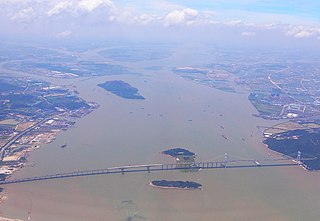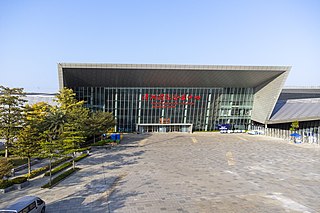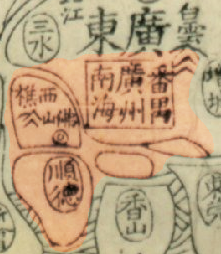
Guangzhou, also known as Canton, is the capital and largest city of Guangdong province in southern China. Located on the Pearl River about 120 km (75 mi) north-northwest of Hong Kong and 145 km (90 mi) north of Macau, Guangzhou has a history of over 2,200 years and was a major terminus of the maritime Silk Road; it continues to serve as a major port and transportation hub as well as being one of China's three largest cities. For a long time it was the only Chinese port accessible to most foreign traders. Guangzhou was captured by the British during the First Opium War and no longer enjoyed a monopoly after the war; consequently it lost trade to other ports such as Hong Kong and Shanghai, but continued to serve as a major transshipment port. Due to a high urban population and large volumes of port traffic, Guangzhou is classified as a Large-Port Megacity, the largest type of port city in the world. Due to worldwide travel restrictions at the beginning of the COVID-19 pandemic, Guangzhou Baiyun International Airport, the major airport of Guangzhou, briefly became the world's busiest airport by passenger traffic in 2020.

Zhongshan is a prefecture-level city in the south of the Pearl River Delta in Guangdong province, China. As of the 2020 census, the whole city with 4,418,060 inhabitants is now part of the Guangzhou–Shenzhen conurbation with 65,565,622 inhabitants. The city-core subdistricts used to be called Shiqi or Shekki.

The Pearl River Delta Metropolitan Region is the low-lying area surrounding the Pearl River estuary, where the Pearl River flows into the South China Sea. Referred to as the Guangdong-Hong Kong-Macao Greater Bay Area in official documents, the region is one of the most densely populated and urbanized regions in the world, and is considered a megacity by numerous scholars. It is currently the wealthiest region in Southern China and one of the wealthiest regions in China along with the Yangtze River Delta in Eastern China and Jingjinji in Northern China. Most of the region is part of the Pearl River Delta Economic Zone, which is a special economic zone of China.

The Pearl River is an extensive river system in southern China. "Pearl River" is often also used as a catch-all for the watersheds of the Pearl tributaries within Guangdong, specifically the Xi ('west'), Bei ('north'), and Dong ('east'). These rivers all ultimately flow into the South China Sea through the Pearl River Delta. Measured from the farthest reaches of the Xi River, the 2,400-kilometer-long (1,500 mi) Pearl River system constitutes China's third-longest, after the Yangtze River and the Yellow River, and its second largest by volume, after the Yangtze. The 453,700 km2 (175,200 sq mi) Pearl River Basin drains the majority of Guangdong and Guangxi provinces, as well as parts of Yunnan, Guizhou, Hunan and Jiangxi; it also drains the northernmost parts of Vietnam's Northeast Cao Bằng and Lạng Sơn provinces. The Pearl River is famed as the river that flows through Guangzhou.

Chu Kong Passenger Transport Co., Ltd. is a subsidiary of Chu Kong Shipping Enterprises (CKS) and operates ferry services between Hong Kong and cities in Guangdong province, China, as well as Macau.

The Bund is a waterfront area and a protected historical district in central Shanghai. The area centers on a section of Zhongshan Road within the former Shanghai International Settlement, which runs along the western bank of the Huangpu River in the eastern part of Huangpu District. The area along the river faces the modern skyscrapers of Lujiazui in the Pudong District. The Bund usually refers to the buildings and wharves on this section of the road, as well as some adjacent areas. This region has a significant European influence, with the style of many structures most comparable to that of European cities, particularly Gothic, Baroque, Neoclassical, Romanesque, Art Deco, and Renaissance architecture. Additionally, some of the city's top eateries are located there. From the 1860s to the 1930s, it was the rich and powerful center of the foreign establishment in Shanghai, operating as a legally protected treaty port.

Foshan, alternately romanized as Fatshan, is a prefecture-level city in central Guangdong Province, China. The entire prefecture covers 3,848 km2 (1,486 sq mi) and had a population of 9,498,863 as of the 2020 census. The city is part of the western side of the Pearl River Delta Economic Zone whose built-up area was home to 65,694,622 inhabitants as of 2020, making it the biggest urban area of the world.

The Guangzhou Metro is the rapid transit system of the city of Guangzhou in the Guangdong Province of China. It is operated by the state-owned Guangzhou Metro Corporation and was the fourth metro system to be built in mainland China, after those of Beijing, Tianjin, and Shanghai.

Shunde is a district of the city of Foshan, Guangdong province, located in the Pearl River Delta. It had a population of 2,464,784 as of the 2010 census. Once a traditional agricultural county, it has become one of the most affluent counties in Guangdong and mainland China. Since 2009 it has been administered independently of Foshan city, answerable directly to the Guangdong provincial government.

Panyu, alternately romanized as Punyu, is one of 11 urban districts of the prefecture-level city of Guangzhou, the capital of Guangdong Province, China. It was a separate county-level city before its incorporation into modern Guangzhou in 2000. The present district covers an area of about 530 km2 (200 sq mi).
Port of Guangzhou is the main seaport of Guangzhou city, Guangdong province, China. The port is operated by Guangzhou Port Group Co. Ltd which is a state owned company. The company was established on February 26, 2004 from the former Guangzhou Harbor Bureau. It was approved by the Guangzhou Municipal Government. It is currently the largest comprehensive port in South China. Its international maritime trade reaches over 300 ports in more than 80 countries and districts worldwide. The port also incorporates the former Huangpu Port.

Beijiao is a town in the district of Shunde, in the prefecture-level city of Foshan, Guangdong, China. The town covers an area of 92.11 square kilometres (35.56 sq mi). Per a 2020 publication by the government of Shunde District, Beijiao has a permanent population of about 420,000 people; Beijiao has a hukou population of 150,695 as of 2018.

Nansha District and Nansha New Area is one of 11 urban districts and a state-level new area of the prefecture-level city of Guangzhou, the capital of Guangdong Province, China. It is the home of the present-day port of Guangzhou, as well as the Nansha Wetland Park.

Ronggui railway station is an elevated station on the Guangzhou-Zhuhai Intercity Railway.

Line 7 of the Guangzhou Metro is a rapid transit line in Guangzhou and Foshan, Guangdong Province, China. It is envisioned as tangential line that runs across southeast Guangzhou and Foshan, allowing for orbital traffic between the suburbs of Shunde, Panyu and Huangpu to avoid the crowded stations in the city center. Line 7's color is ■ light green.

Sanyi or Nanpanshun, also known by Cantonese romanizations such as Sam Yup and Nam Pun Shun, refers to the three districts of Nanhai, Panyu and Shunde surrounding Guangzhou and Foshan in Guangdong, China.
Line 11 of Foshan Metro (FMetro) (Chinese: 佛山地铁11号线; pinyin: Fóshān Dìtiě Shíyīhàoxiàn) is a line under planning in Foshan. The first phase of the line will run in a north–south direction, connecting Hedongdong in Liwan District in Guangzhou with Rongqi Ferry in Shunde District, with 18 stations and 36.3 km (22.6 mi) kilometers of track.















